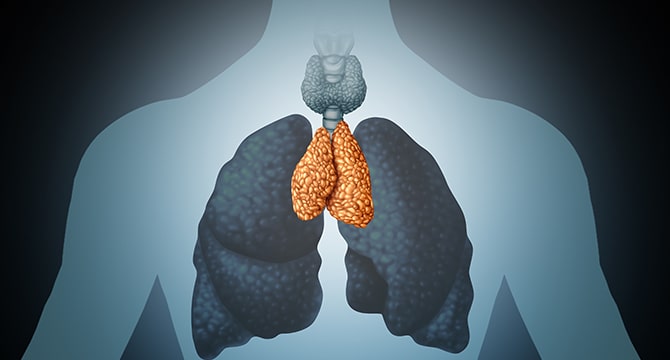- https:
//myasthenia.org/What-is-MG/MG-Materials-Webinars/Brochures-Learn-More-About-MG/thymectomy - https:
//www.myastheniagravis.org/about-mg/what-is-mg/ - https:
//myasthenia.org/Newly-Diagnosed/Treatment-Strategy - https:
//www.myastheniagravis.org/about-mg/treatments/ - https:
//my.clevelandclinic.org/health/treatments/17555-thymectomy-for-myasthenia-gravis - https:
//myasthenia.org/MG-Education/Learn-More-About-MG-Treatments/MG-Brochures/thymectomy
Thymus
What is the Thymus Gland?
The Thymus Gland sits inside the chest, behind the breastbone (Sternum) and in front of the heart between the lungs. The Thymus plays an important part in the development of our immune system and is responsible for producing the type of white blood cells (T cells) that help our bodies fight infections and viruses. The gland maintains the production of the important antibodies that control Acetylcholine (the chemical messenger controlling all our voluntary muscles). The Thymus grows gradually until puberty. When it reaches its maximum size, the gland starts to get smaller.
The Thymus controls our immune function, which is why it is associated with Myasthenia Gravis. In people with MG, the Thymus Gland remains large and may give incorrect instructions to developing immune cells.


Treatment
In some cases, treating the condition by removing the Thymus Gland can reduce muscle weakness and the need for drugs like immunosuppressants. As the procedure effectively rebalances the immune system, a thymectomy can limit symptoms and even cure Myasthenia Gravis. The goal of a thymectomy is to remove the source of the abnormal antibody production. The benefits of surgery are not immediate and most people take time to respond to the treatment. After the procedure patients continue with their medication as prescribed with the goal of reducing medication over time. Responses to surgery will depend on a person’s age, their response to prior medical therapy, and the severity and length of time they have had MG. There are three different techniques for thymectomy available. Your neurologist and surgeon will advise whether surgery is an option for you, and if so which type is most appropriate.
The three possible kinds of thymectomy are Transsternal, Transcervical, and Videoscopic (VATS). The goal of all these techniques is to remove the entire Thymus Gland, regardless of how the procedure is carried out.
Should I have a thymectomy?
A thymectomy is often recommended for patients under 60 years of age with moderate to severe MG. This type of surgery may also be necessary if you are only experiencing mild weakness but are also having trouble breathing or swallowing. It is not advisable for anyone suffering exclusively from the condition of Ocular MG. Your healthcare provider will assess your unique situation and can advise whether you should have the procedure. Around 10% of patients living with MG may have a Thymus tumour known as a Thymoma. These tumours tend to grow slowly and will occasionally be cancerous, although this is rare. Your medical professional may suggest a chest CT scan to check for a tumour as part of your physical assessment.
Many patients go on to improve within a year of having the surgery, with some very successful operations resulting in permanent remission without the need for continued medication. Remission rates after one year are in the range of 20-40% of procedures performed. Reassuringly, some specialists agree that successful remission rates improve five or more years after surgery - between 40-60%.

Diagnosis & Treatment
What can you do to alleviate your condition, and what treatments are available?
Read more
Living with gMG
Living with gMG can mean coping with uncertainty. Learn how to control your symptoms day today
Read moreIf you are concerned about anything you have read in this article, please seek advice from your healthcare provider.
References


